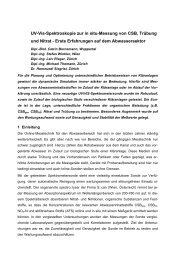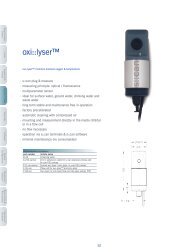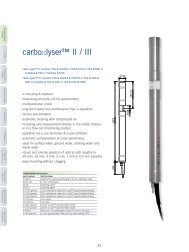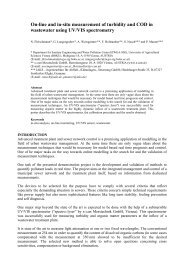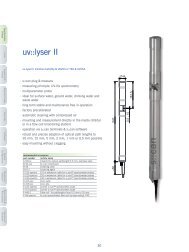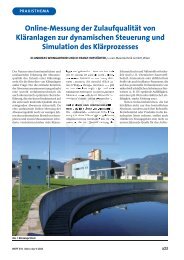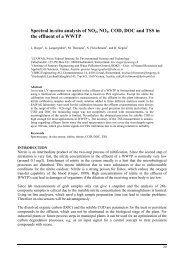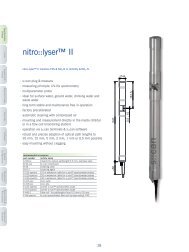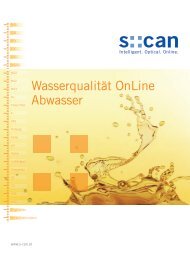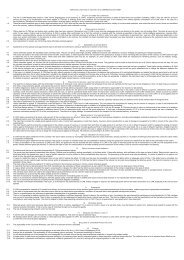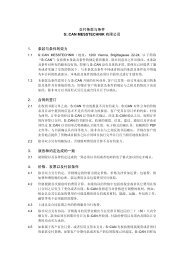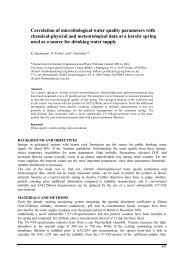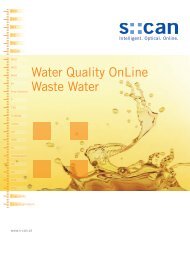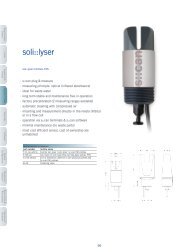Water Quality OnLine Drinking Water - S-can
Water Quality OnLine Drinking Water - S-can
Water Quality OnLine Drinking Water - S-can
You also want an ePaper? Increase the reach of your titles
YUMPU automatically turns print PDFs into web optimized ePapers that Google loves.
The s::<strong>can</strong> solution<br />
The spectrometer probe<br />
Let’s get out of the laboratory, and into the water. Away from the<br />
complicated and high-maintenance cabinet analysers towards reliable<br />
and simple online technologies and, above all, submersible<br />
spectrometers. A “mega trend” for the future of water management?<br />
We are convinced of it. s::<strong>can</strong> spectrometer probes need<br />
practically no maintenance, are extremely robust and durable and<br />
keep measuring for years, 24 hours a day, to the complete satisfaction<br />
of the operators. The advantages are obvious and are described<br />
later in more detail for the individual measurement parameters.<br />
Spectrometric Photometric Cabinet analyser<br />
Accuracy ��� � ����<br />
Stability (drift) ���� ��� ��<br />
Calibration effort ��� �� ����<br />
Maintenance effort ����� ���� �<br />
Purchase costs ���� ���� �<br />
Operating costs ����� ���� �<br />
Comparison of various procedures for monitoring organic chemistry<br />
The spectrometer probe …<br />
... provides several crucial advantages over simple photometer<br />
probes:<br />
1) Up to 8 major parameters <strong>can</strong> be measured at once. This flexibility<br />
also permits expansion of the range of parameters for future<br />
applications which you are probably not thinking of at all today.<br />
2) Measurement is incomparably more stable with regard to crosssensitivities<br />
and therefore more accurate than photometer probes<br />
by entire orders of magnitude, especially in difficult applications.<br />
3) Even in special applications, there is almost always a spectral<br />
range that correlates well with the substance of interest. In the<br />
event of major changes in water composition, only a new spectral<br />
calibration is required.<br />
4) A large number of individual substances <strong>can</strong> also be identified<br />
against a fluctuating background matrix and separately quantified<br />
with the application of chemometric methods (e.g. BTX, phenols,<br />
solvents, flavouring agents etc.), which does not work at all with<br />
simple photometric probes.<br />
5) Distinguishing between total and dissolved substances is possible:<br />
s::<strong>can</strong> uses a sophisticated mathematical algorithm that permits<br />
this distinction to be made reliably and usually works even<br />
without calibration.<br />
6) The intelligent “spectral alarm” permits detection of deviations<br />
from a normal composition (“event detection”) and provides an<br />
associated alarm signal. This method is now acknowledged and in<br />
use around the world, e.g. in drinking water and river water alarm<br />
systems and in industrial discharge monitoring.<br />
Conventional solutions<br />
The traditional cabinet analyser<br />
This type of instrument has been in use for about the last 30 years<br />
for measuring most chemical parameters. The advantage of such<br />
instruments was always with the manufacturers of consumables<br />
and not with the customers. These instruments <strong>can</strong> often be kept<br />
going only by means of comprehensive service contracts, they consume<br />
chemicals and spare parts, pollute the environment, and<br />
need considerable attention. Frequently they are so expensive and<br />
unreliable in operation that users just shut these instruments down<br />
again after some period of use.<br />
The simple photometric probe<br />
... despite its disadvantages, is still in widespread use today, probably<br />
because for a long time there simply was no better replacement<br />
available for monitoring organic carbon compounds (by correlation<br />
with the UV absorption signal at 254 nm). It is also used for monitoring<br />
nitrate (e.g. by correlation at 220 nm).<br />
Since this probe <strong>can</strong> only ever measure one parameter, the optical<br />
filter would have to be changed to measure other substances, creating<br />
a great deal of work, and then the probe <strong>can</strong> in turn monitor<br />
only this one parameter: flexibility is very restricted..The measurement<br />
of COD <strong>can</strong> be rendered impossible simply by the discharge<br />
of a new industrial emitter into the sewage system.<br />
However, with clear water and completely stable water composition,<br />
good results <strong>can</strong> sometimes be achieved. With fluctuations<br />
in turbidity, a second wavelength must also be measured for compensation,<br />
still this does not work nearly as well as full spectral<br />
compensation (see picture). This alone lifts these sensors up to the<br />
price level of s::<strong>can</strong> spectral instruments .<br />
Since these probes remain restricted to single parameter monitoring,<br />
a substantial cost disadvantage compared with a spectral<br />
probe arises. These simple probes are just not able to cope with<br />
matrix fluctuations and they often provide results that are not sufficiently<br />
correlated with the true concentration values, or with the<br />
reference method.<br />
10<br />
© s::<strong>can</strong> Messtechnik GmbH



